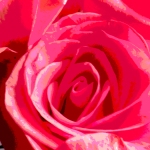 “If you take a flower in your hand and really look at it, it’s your world for a moment.” Georgia O’Keeffe
“If you take a flower in your hand and really look at it, it’s your world for a moment.” Georgia O’Keeffe
“Nobody sees a flower – really – it is so small it takes time – we haven’t time – and to see takes time, like to have a friend takes time.” Georgia O’Keeffe
Georgia O’Keeffe’s paintings and thoughts about flowers are impressive and thought provoking. Her thoughts suggest mindfulness and reflection. Her paintings translate the small and easily overlooked, into something large that captures attention.
My students are always impressed with Georgia’s work. But, while they marvel at the size of her flowers, I think they have a difficult time wrapping their minds around the changes she makes. In Georgia’s hands, flowers became larger than life – even larger than the canvas on which she painted.
I have done Georgia O’Keefe inspired art with my classes other years, and each time they struggled to use the whole page. They made lovely flowers but they made them small – in the center of the page – not covering the whole page. I encouraged and reminded, but still the flowers were smaller than Georgia’s. I loved watching them examine the flowers, but I hated the feeling of pushing them, and constantly having to say “Oh, can you make that bigger?” or “The whole page, use the whole page!” or thinking in my head “eee GADS, that’s not what I asked you to do.”
This year I tried a new method. I wish I could remember the lesson or book that contained the spark which led to this lesson, because I would love to thank them, and give you a great resource, but alas, I cannot. So, you will have to be satisfied with my lesson!
First we looked at her flowers and talked about what we noticed. One thing we noticed was that Georgia’s flowers often look like they go beyond the edge of her canvas. “Oh YES!” I excitedly exclaimed. “EXACTLY!” I told them I had never been able to figure out a way to help my students draw their flowers off the edges of the paper – until now! I told them I read about what other artists had done, and I found something I thought would work perfectly for us.
I explained that I had covered the tables with white craft paper so they would feel free to draw off the edges of the page. I told them their art piece would actually be the piece of watercolor paper I had taped to the white craft paper (I taped them underneath.) but I said they should imagine the whole white space as their canvas. “When you draw your flower, make it big. Make parts of it land on the white craft paper!”
They asked if they would draw a flower from memory. “No! I brought lots of flowers for you to look at!” I dropped many flowers on the carpet in front of them amidst “ooohs” and “aahs.”
“I want you to be like scientists. I want you to really look at the flower you choose and then create it on your paper.” I suggested they try to make their flower have a shape similar to the flower they chose, but told them they could be creative and change things up a bit. The most important things were to trust themselves as artists, really see the flower (like Georgia did) and to draw their flower big so others would see it too.
Armed with a sharpie marker, I chose my flower and began to draw for them. I made the shapes simple – matching the flower in some ways and changing it in others. I commented that sometimes I changed shapes because it was a bit easier for me to draw, and sometimes I tried really hard to draw exactly what I saw.
They all wanted to know if we would add color. “Absolutely! But, we are going to use a new method.” I brought out a tray of sidewalk chalk, a cup of water and a paintbrush. I explained we would color with the chalk and then smudge it – just a bit – with our fingers. Then, we would use the paintbrush and water to create our a watercolor on the page. I cautioned them against too much water – “Squeeze the brush out like this before you use it. … There will still be plenty of water. Look!” I told them they might have to experiment with the amount of chalk they added and the amount of smudging they did. I showed them a few different possibilities and set them free – with my fingers crossed.
After carefully choosing a flower, and navigating how more than one might use the same flower, they uncapped their sharpies and began drawing. They were fantastic!!! All the girls made their drawings larger than the flower they observed, and all but one extended their flowers beyond the page. And, perhaps best of all, it was so easy for them!!!!
They were incredibly engaged in every step of the process – choosing a flower, observing it, drawing it with the black sharpie, coloring with sidewalk chalk, smudging the chalk and turning the chalk into watercolor. I wish I could share photos of their faces with you. They were girls – 5 and 6 years old – transformed into intent, focused artists – easily mistaken for students well beyond their years.
As always I was impressed (and humbled) to be there for the “magic” that took place in that art class. Together, somehow, my students and I found that synergistic space where we were able to become more than … or perhaps just exactly … who we are.
….
Two nice Georgia O’Keeffee resources:



